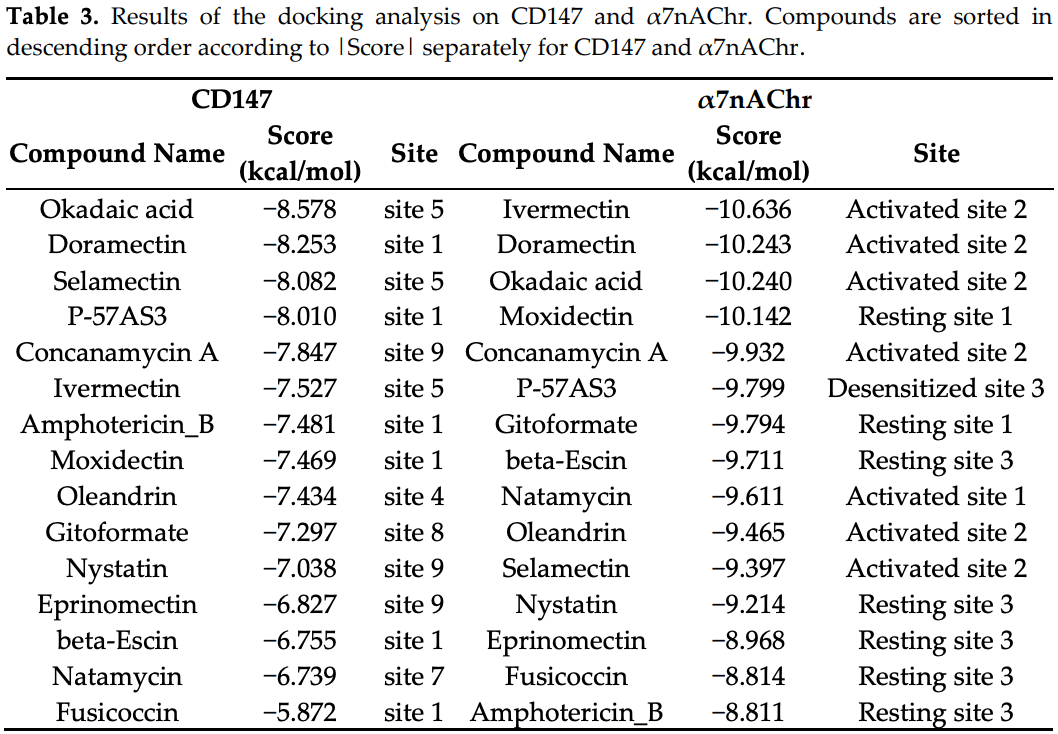DOI record:
{
"DOI": "10.3390/computation10040051",
"ISSN": [
"2079-3197"
],
"URL": "http://dx.doi.org/10.3390/computation10040051",
"abstract": "<jats:p>Some clinical studies have indicated activity of ivermectin, a macrocyclic lactone, against COVID-19, but a biological mechanism initially proposed for this anti-viral effect is not applicable at physiological concentrations. This in silico investigation explores potential modes of action of ivermectin and 14 related compounds, by which the infectivity and morbidity of the SARS-CoV-2 virus may be limited. Binding affinity computations were performed for these agents on several docking sites each for models of (1) the spike glycoprotein of the virus, (2) the CD147 receptor, which has been identified as a secondary attachment point for the virus, and (3) the alpha-7 nicotinic acetylcholine receptor (α7nAChr), an indicated point of viral penetration of neuronal tissue as well as an activation site for the cholinergic anti-inflammatory pathway controlled by the vagus nerve. Binding affinities were calculated for these multiple docking sites and binding modes of each compound. Our results indicate the high affinity of ivermectin, and even higher affinities for some of the other compounds evaluated, for all three of these molecular targets. These results suggest biological mechanisms by which ivermectin may limit the infectivity and morbidity of the SARS-CoV-2 virus and stimulate an α7nAChr-mediated anti-inflammatory pathway that could limit cytokine production by immune cells.</jats:p>",
"alternative-id": [
"computation10040051"
],
"author": [
{
"affiliation": [],
"family": "Aminpour",
"given": "Maral",
"sequence": "first"
},
{
"affiliation": [],
"family": "Cannariato",
"given": "Marco",
"sequence": "additional"
},
{
"affiliation": [],
"family": "Preto",
"given": "Jordane",
"sequence": "additional"
},
{
"affiliation": [],
"family": "Safaeeardebili",
"given": "M. Ehsan",
"sequence": "additional"
},
{
"affiliation": [],
"family": "Moracchiato",
"given": "Alexia",
"sequence": "additional"
},
{
"affiliation": [],
"family": "Doria",
"given": "Domiziano",
"sequence": "additional"
},
{
"affiliation": [],
"family": "Donato",
"given": "Francesca",
"sequence": "additional"
},
{
"ORCID": "http://orcid.org/0000-0001-6690-5986",
"affiliation": [],
"authenticated-orcid": false,
"family": "Zizzi",
"given": "Eric Adriano",
"sequence": "additional"
},
{
"ORCID": "http://orcid.org/0000-0003-1918-1772",
"affiliation": [],
"authenticated-orcid": false,
"family": "Deriu",
"given": "Marco Agostino",
"sequence": "additional"
},
{
"ORCID": "http://orcid.org/0000-0001-6841-7054",
"affiliation": [],
"authenticated-orcid": false,
"family": "Scheim",
"given": "David E.",
"sequence": "additional"
},
{
"ORCID": "http://orcid.org/0000-0003-4724-9738",
"affiliation": [],
"authenticated-orcid": false,
"family": "Santin",
"given": "Alessandro D.",
"sequence": "additional"
},
{
"ORCID": "http://orcid.org/0000-0001-9976-0429",
"affiliation": [],
"authenticated-orcid": false,
"family": "Tuszynski",
"given": "Jack Adam",
"sequence": "additional"
}
],
"container-title": [
"Computation"
],
"content-domain": {
"crossmark-restriction": false,
"domain": []
},
"created": {
"date-parts": [
[
2022,
3,
25
]
],
"date-time": "2022-03-25T19:31:21Z",
"timestamp": 1648236681000
},
"deposited": {
"date-parts": [
[
2022,
3,
25
]
],
"date-time": "2022-03-25T20:06:29Z",
"timestamp": 1648238789000
},
"indexed": {
"date-parts": [
[
2022,
3,
26
]
],
"date-time": "2022-03-26T12:43:21Z",
"timestamp": 1648298601316
},
"is-referenced-by-count": 0,
"issn-type": [
{
"type": "electronic",
"value": "2079-3197"
}
],
"issue": "4",
"issued": {
"date-parts": [
[
2022,
3,
25
]
]
},
"journal-issue": {
"issue": "4",
"published-online": {
"date-parts": [
[
2022,
4
]
]
}
},
"language": "en",
"license": [
{
"URL": "https://creativecommons.org/licenses/by/4.0/",
"content-version": "vor",
"delay-in-days": 0,
"start": {
"date-parts": [
[
2022,
3,
25
]
],
"date-time": "2022-03-25T00:00:00Z",
"timestamp": 1648166400000
}
}
],
"link": [
{
"URL": "https://www.mdpi.com/2079-3197/10/4/51/pdf",
"content-type": "unspecified",
"content-version": "vor",
"intended-application": "similarity-checking"
}
],
"member": "1968",
"original-title": [],
"page": "51",
"prefix": "10.3390",
"published": {
"date-parts": [
[
2022,
3,
25
]
]
},
"published-online": {
"date-parts": [
[
2022,
3,
25
]
]
},
"publisher": "MDPI AG",
"reference-count": 0,
"references-count": 0,
"relation": {},
"resource": {
"primary": {
"URL": "https://www.mdpi.com/2079-3197/10/4/51"
}
},
"score": 1,
"short-container-title": [
"Computation"
],
"short-title": [],
"source": "Crossref",
"subject": [
"Applied Mathematics",
"Modeling and Simulation",
"General Computer Science",
"Theoretical Computer Science"
],
"subtitle": [],
"title": [
"In Silico Analysis of the Multi-Targeted Mode of Action of Ivermectin and Related Compounds"
],
"type": "journal-article",
"volume": "10"
}
